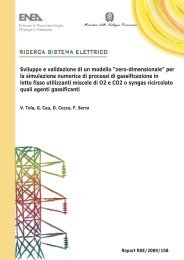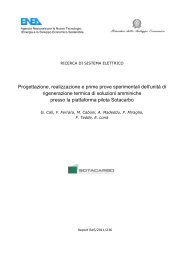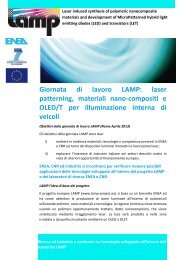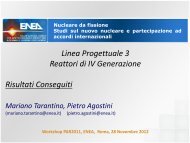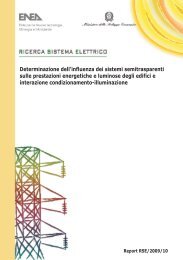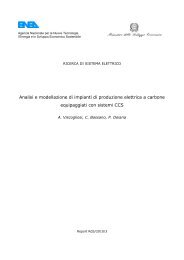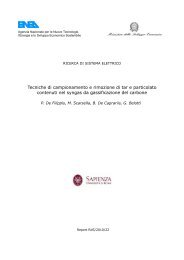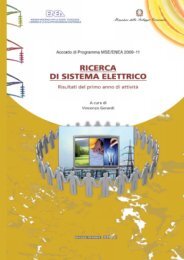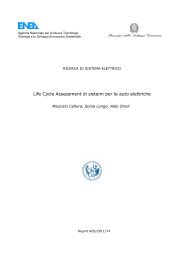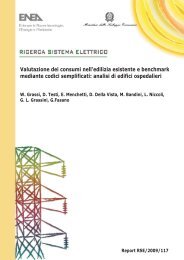Sviluppo di moduli batterie litio-ioni per avviamento - Enea
Sviluppo di moduli batterie litio-ioni per avviamento - Enea
Sviluppo di moduli batterie litio-ioni per avviamento - Enea
You also want an ePaper? Increase the reach of your titles
YUMPU automatically turns print PDFs into web optimized ePapers that Google loves.
Figura 66 – Ren<strong>di</strong>mento energetico in funzione della corrente <strong>di</strong> scarica @ 23°C<br />
Dai grafici si nota che l’energia erogata presenta un andamento simile a quello della capacità:<br />
<strong>di</strong>minuisce all’aumentare della corrente <strong>di</strong> scarica. Simile è anche la caratteristica del<br />
ren<strong>di</strong>mento energetico rispetto a quello <strong>di</strong> carica: esso assume <strong>per</strong>ò valori molto più piccoli.<br />
Dividendo l’energia <strong>per</strong> il valore del volume si ottiene la densità energetica, mentre <strong>di</strong>videndo<br />
<strong>per</strong> il valore della massa si ottiene l’energia specifica: nella tabella della pagina seguente tali<br />
parametri sono riportati sia in funzione dello C rate.<br />
C rate<br />
Energia specifica e densità <strong>di</strong> energia<br />
in funzione della corrente <strong>di</strong> scarica @23°C<br />
Corrente <strong>di</strong> scarica<br />
[A]<br />
Energia specifica<br />
[Wh/kg]<br />
Densità <strong>di</strong> energia<br />
[Wh/l]<br />
C/2 10 113.4494 140.9755<br />
1C 20 111.5393 138.6020<br />
2C 40 108.2135 134.4692<br />
Tabella 34 – Energia specifica e densità <strong>di</strong> energia in funzione della corrente <strong>di</strong> scarica @23°C<br />
Resistenza interna, OCV e potenza <strong>di</strong> picco<br />
La prova inizia con un <strong>per</strong>iodo <strong>di</strong> pausa, seguito da tre impulsi <strong>di</strong> corrente della durata <strong>di</strong> 30<br />
secon<strong>di</strong> intervallati da brevi <strong>per</strong>io<strong>di</strong> <strong>di</strong> pausa. I primi due impulsi sono a 1C in scarica ed in<br />
carica ed il terzo è un impulso <strong>di</strong> scarica ad alta corrente. La prova è stata eseguita alla<br />
tem<strong>per</strong>atura <strong>di</strong> 23°C ed a SOC 50%: questo valore dello stato <strong>di</strong> carica è stato ottenuto<br />
scaricando precedentemente la batteria alla corrente C/2. La sequenza è descritta nella<br />
Tabella.<br />
Ren<strong>di</strong>mento [%]<br />
0,92<br />
0,9<br />
0,88<br />
0,86<br />
Prestaz<strong>ioni</strong> delsistema 48V - 20Ah in scarica<br />
Ren<strong>di</strong>mento energetico in funzione della corrente <strong>di</strong> scarica<br />
@ 23°C<br />
0 5 10 15 20 25 30 35 40 45<br />
Corrente <strong>di</strong> scarica [A]<br />
Fase n. Descrizione Tempo<br />
1 P < 3 ore<br />
2 DSCH @ 1C 30 sec<br />
3 P 180 sec<br />
4 CH @ 1C 30 sec<br />
5 P 180 sec<br />
6 DSCH @ IHC 30 sec<br />
7 P 180 sec<br />
Tabella 35 - Sequenza <strong>per</strong> la misura della res. int., OCV e potenza.<br />
La corrente IHC usata nella fase 6 è definita come il più alto valore consentito <strong>di</strong> corrente che<br />
può essere usato <strong>per</strong> 30 secon<strong>di</strong> in accordo con le specifiche del Costruttore. Nel caso in esame<br />
90



